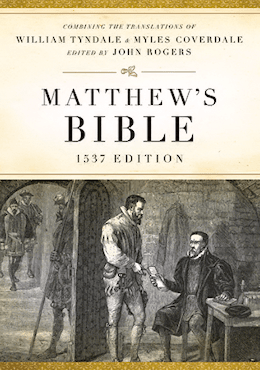Textus Receptus Bibles
Matthew's Bible 1537
| 9:1 | I sawe the Lord standynge vpon the aulter, and he sayde; smyte the dore cheke, that the postes maye shake withall. For theyr couetousnesse shal fall vpon al their heades, and their posterite shalbe slayne wyth the swerde. They shall not fle awaye, there shall not one of them escape, ner be delyuered. |
| 9:2 | Though they were buryed in the hell, my hande shall fetch them from thence: though they clymme vp to heauen, yet shall I cast them downe: |
| 9:3 | though they hyde them selues vpon the toppe of Carmell, yet shall I seke them out, and brynge them from thence: Though they crepe downe from my syght into the depe of the sea, I shall commaunde the serpente, euen there to byte them. |
| 9:4 | If they goo awaye before their enemyes in to captyuite, then shall I commaunde the swerde, there to slayue them. Thus wyll I sett myne eyes vpon them, for their harme, & not for their wealth. |
| 9:5 | For when the Lorde God of hoostes toucheth a lande, it consumeth awaye, and all they that dwell therin, muste nedes mourne: And why? theyr destruccyon shall aryse as euery streame and runne ouer them, as the floude in Egipte. |
| 9:6 | He that hath hys dwellynge in heauen, & groundeth hys tabernacle in the earth: He that calleth the waters of the sea, and poureth them out vpon the playne grounde: hys name is the Lorde. |
| 9:7 | O ye chyldren of Israell, are ye not vnto me, euen as the Moryans, sayeth the Lorde? haue not I brought Israell out of the land of Egypte, the Philystues from Capthor, and the Sirians from Cyr? |
| 9:8 | Beholde, the eyes of the Lorde are vpon the realme that synneth, to rote it clene out of the earth: Neuertheles, I wyll not vtterly destroye the house of Iacob, sayeth the Lorde. |
| 9:9 | For lo thys I promyse: though I syfte the house of Israell amonge all nacyons (like as they vse to lyfte in a syue) yet shall not the smallest grauell stone fall vpon the earth: |
| 9:10 | But all the wicked doers of my people, that saye: Tush, the plage is not so nye, to come so hastely vpon vs: those shall perish with the swerde. |
| 9:11 | At that tyme wyll I buylde agayne the tabernacle of Dauid, that is fallen downe and hedge vp hys gappes: and loke what is broken, I shall repayre it: Yee I shall buylde it agayne, as it was a fore tyme, |
| 9:12 | that they maye possesse the remnaunt of Edom, yee & all soch people as call vpon my name wyth them sayeth the Lorde, whyche doeth these thynges. |
| 9:13 | Beholde, the tyme commeth (sayeth the Lorde) that plowman shall ouer take the mower, & the treader of grappes, hym that soweth sede. The mountaynes shall droppe swete wyne, and the hylles shalbe fruyteful, |
| 9:14 | and I will turne the captyuyte of my people of Israell: they shall repayre the waste cytyes, and haue them in possession: they shal plante vynyardes, and drinke the wine therof: they shal make gardens, & enioye the fruytes of them. |
| 9:15 | And I wyll plante them vpon their owne grounde, so that I wyll neuer rote them out agayne from their lande which I haue geuen them sayeth the Lorde thy God. |

Matthew's Bible 1537
The Matthew Bible, also known as Matthew's Version, was first published in 1537 by John Rogers, under the pseudonym "Thomas Matthew". It combined the New Testament of William Tyndale, and as much of the Old Testament as he had been able to translate before being captured and put to death, with the translations of Myles Coverdale as to the balance of the Old Testament and the Apocrypha, except the Apocryphal Prayer of Manasses. It is thus a vital link in the main sequence of English Bible translations.